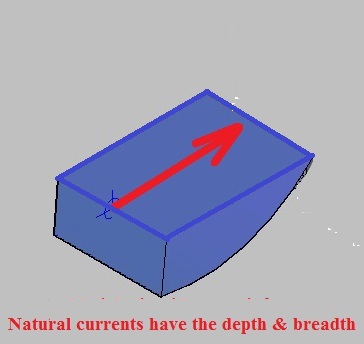Những vấn đề cơ bản trong nghiên cứu điện thủy triều và điện hải lưu ở Việt Nam ( English attached at the end) )

Có 3 yếu tố để hình thành dòng hải lưu 1 chiều dọc theo bờ biển miền Trung Việt Nam theo hướng từ Bắc xuống Nam:
1- Dòng tầng đáy mạnh và tồn tại 365 ngày/năm vì 5 điều kiện sau :
Chênh lệch nhiệt giữa Xích đạo và Bắc cực.
Dòng đáy xuất phát từ Bắc cực.
Hiện tượng xảy ra khi gần Xích đạo.
Bờ biển Nhật và Trung quốc lệnh dần về phía Tây khi tiến về Xích đạo.
Những đặc điểm đặc biệt về hướng của bờ biển miền Trung Việt Nam.
2- Việt Nam là khu vực gió mùa. Dòng mặt hình thành do gió Đông Bắc.Dòng mặt và dòng đáy cùng một hướng. Đó là sự cộng hưởng của hai dòng hải lưu.
3- Nhờ có dãy Trường Sơn và đặc điểm của bờ biển miền Trung nên bờ biển miền Trung chịu ảnh hưởng rất ít gió mùa Tây Nam.
Hạn chế gì đối với hệ thống chuyển đổi năng lượng mới nhất hiện nay ?
1. Dòng chảy có độ sâu và độ rộng nhưng hệ thống chuyển đổi năng lượng hiện nay chỉ tiếp nhận nguồn năng lượng cắt ngang qua vùng hoạt động của cánh quạt. Điều đó có nghĩa là hiệu quả sử dụng năng lượng của dòng biển quá thấp.
2. Tất cả cánh quạt đều có trọng lượng nên giảm hiệu quả hệ thống chuyển đổi năng lượng.
Hệ thống chuyển đổi năng lượng tốt nhất là cách nào ?
Thủy điện sử dụng thế năng của nước (E=mgh) còn ở đây mục tiêu của chúng ta là sử dụng động năng của nước ( E= 0.5 mvv). Vì vậy giải pháp là khác nhau.
Ở đây chúng ta dùng trống quay như một cánh quạt và cánh quay quanh trục đứng của hình trụ tròn.Chuyển động của hình trụ tròn quay quanh trục của nó là loại chuyển động gặp ít sức cản nhất trong nước.Trong trống quay có độ rỗng thích hợp để khử trọng lượng của hệ thống quay bằng lực đẩy Archimedes.
Với cách trên, hệ thống chuyển đổi năng lượng này có thể chuyển đổi năng lượng với dòng biển có tốc độ thấp.
English
Some elements in studying hydrokinetic energy for tidal current and sea current in Vietnam
Characteristics of water currents in studying :
Tidal current : Studying the tidal currents, it is up with one direction and down with its contrary directions.
Sea curreent : Studying the sea current at the Vietnam central part, I have discovered that there are 6 characteristics :
1. It is near the coast ( about some hundred meter from the coast);
2. The water zone is shallow ( 10m-35m) ;
3. The direction is stable from North to South ( the bottom current exists with 365 / year , the surface current exists with 9 months/year );
4. Highest flow speed compared with other coasts in the west of Pacific Ocean ( Taiwan have built Electricity plant used Hydrokinetic energy from Sea Current);
5. The breadth of sea current is large ( It is 24 km large in breadth at the Song Gianh estuary with latitude 170 43’N) ;
6. The length of sea current is 1,000 km from Hon La bay – Quang Binh province with 170 56’N to Ke Ga cap- Binh Thuan – Province with latitude 100 41’N
There are three factors that have formed the one way sea current along the coast in Vietnam central part with the direction from North to South :
1- Bottom sea current is strong and existed on 365 day/ year owing to 5 conditions :
The difference of temperature between Equator and Northern pole.
The bottom current started from the Northern pole.
The phenomenon happen strong is near the Equator.
The coast of Japan and China being toward the west when it runs from northern pole to equator .
Special characteristic in direction of the Vietnam central part coast.
2- Vietnam is in the area of monsoon. The sea surface current be formed by north-east monsoon . The sea surface current and the sea bottom current are the direction. It is the resonant between the above two sea currents .
3- Due to the Truong Son mountain and the characteristic of the coast in Vietnam central part so the above coast be impacted less by South-West monsoon.
What is limitation of the conversion system being update at this time ?
1. The sea current have the depth and the breadth but the conversion system being update at this time receive the hydrokinetic energy that cross the zone operated by blade only. It means that the effect of using the energy of sea current is too low.
2. All the blades have the weight that reduce the effect of energy conversion system
What is the best way for hydrokinetic energy conversion systems ?
Hydroelectricity plant use the potential energy of water (E=mgh) but here , our object is using the hydrokinetic energy ( E= 0.5 mvv). Therefore the method using is difference with other.
Here we use the turning drum as a blade and it turn around its cylinder’s vertical axis. Turning of cylinder around its axis is the moving with reactive power at least in the water.There are a suitable empty space in side of turning drum so that it can cancel all the weight of turning system by Archimedes force.
By the above way, this conversion system can convert the hydrokinetic energy of sea currents with very lowl speed.
Eng. Doãn Mạnh Dũng









